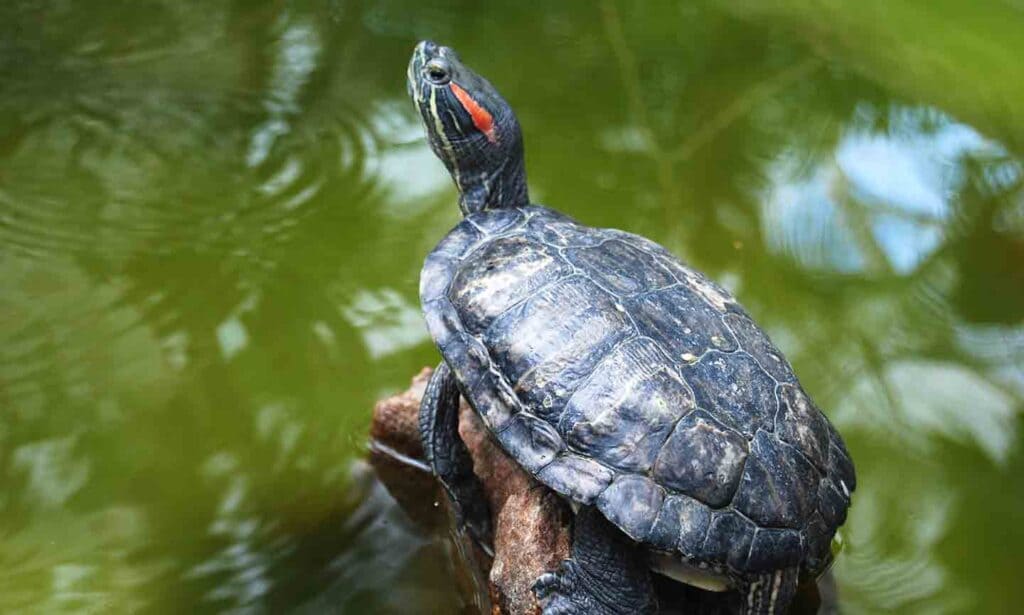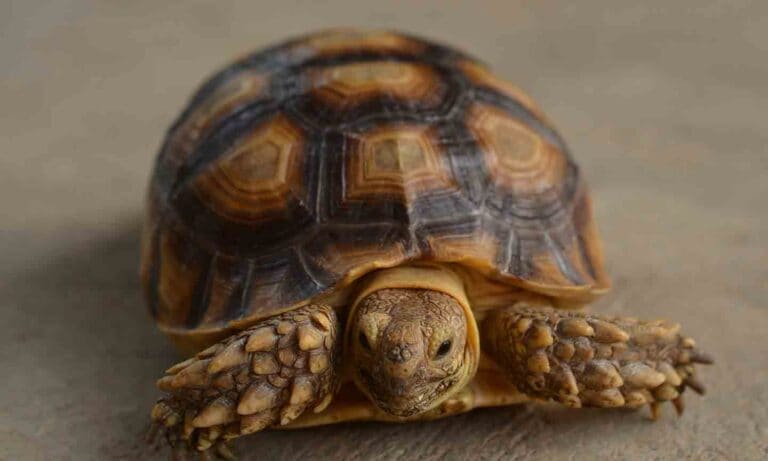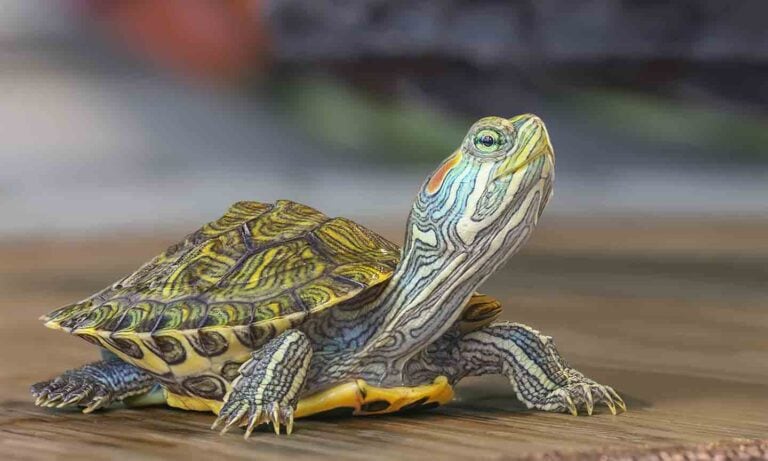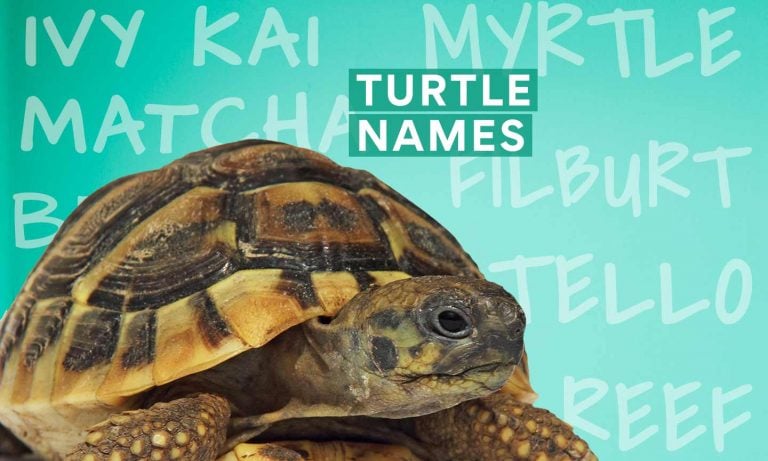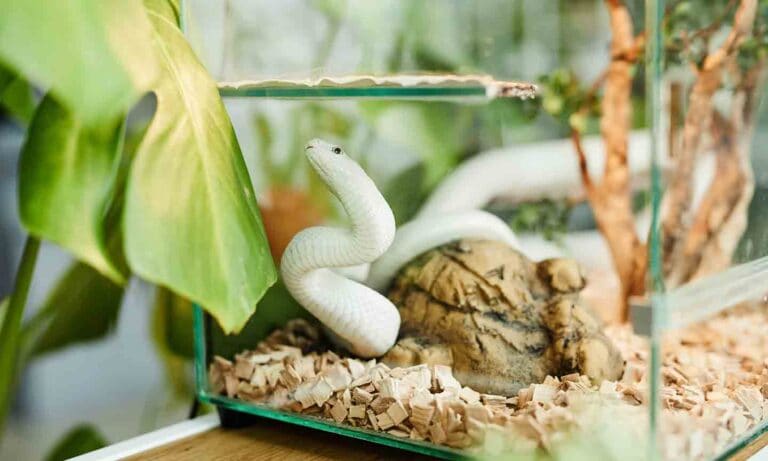In This Guide:
Designing Your Pond for Turtles
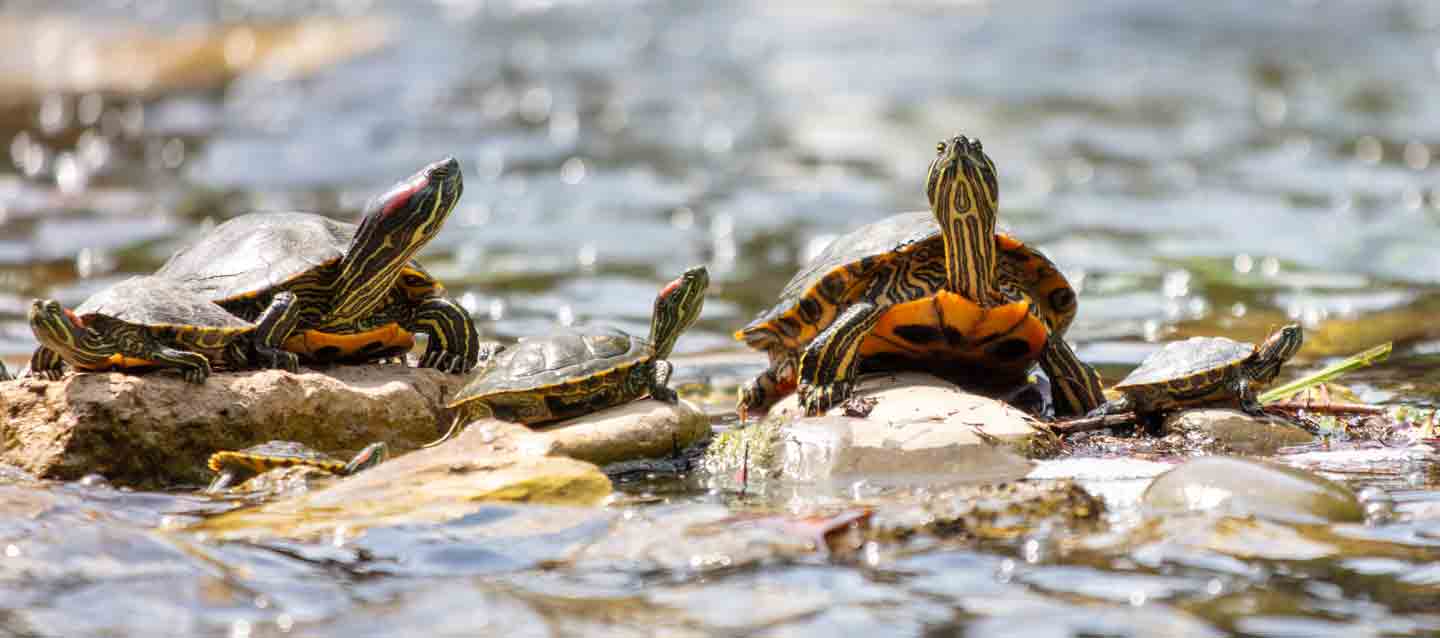
A well-designed pond can provide a safe and healthy habitat for turtles and provide an aesthetic addition to your landscaping.
1. Choosing the Right Location
An ideal location for a turtle pond is visible from your home or outdoor living space and is easily accessible for maintenance. Consider how easily accessible the pond might be to predators as well.
Choose a spot for your pond that gets a mix of sunlight and shade; your turtles will need plenty of swimming space as well as warm basking areas out of the water. Avoid building a pond for turtles in an area prone to runoff and flooding.
2. Ideal Pond Size for Turtles
The ideal size, shape, and depth of a turtle pond will depend on how many turtles will live in it.
Teresa Manucy, DVM, a telehealth veterinarian for Chewy, recommends a minimum pond volume of 100 gallons for a single turtle or 150 gallons for two turtles. For a larger group of turtles, she says, the area should be at least 80 square feet.
A minimum depth of 12–24 inches is required for turtle ponds, though the ideal depth may depend on the species. “The depth should be at least 1.5–2 times the length of the turtle’s shell,” says Dr. Manucy, “and the pond length should be at least 4–6 times the length of their shell.”
Essential Turtle Pond Features
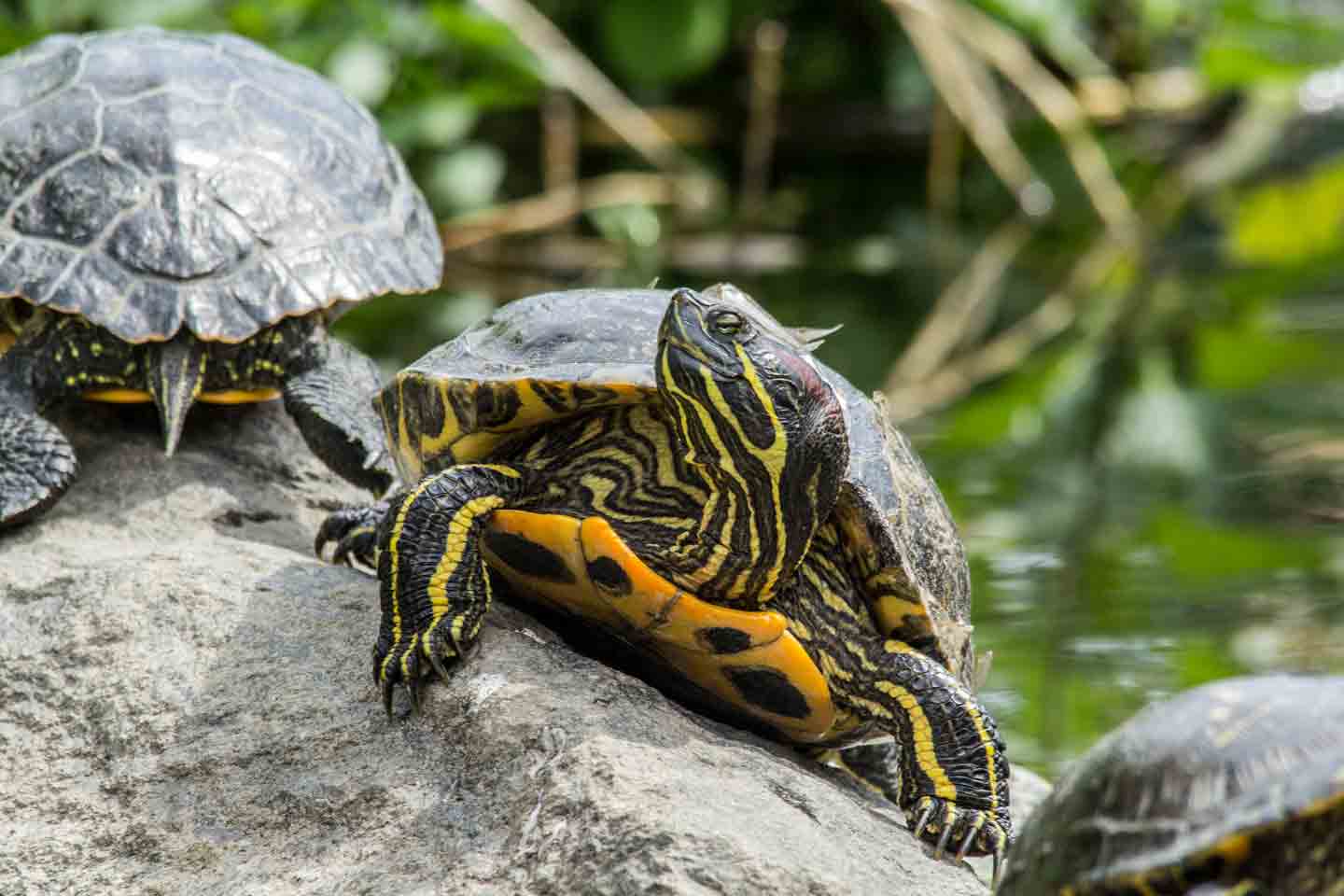
When considering different pond ideas for turtles, there are a few essentials you should be sure to include.
1. Basking Areas and Platforms
Pond turtles generally split their time between swimming or resting underwater, and basking in the sun. Basking helps conserve energy, regulate body temperature, and speed up digestion. Exposure to the UV rays in sunlight also supports the natural production of vitamin D, which is essential for shell health.
Open areas of dry land or flat rock are good for basking. You can also use floating platforms to provide basking areas on the surface of the water. Dr. Manucy recommends utilizing platforms to create a “basking dry zone of 15% to 25% of the pond’s surface area.”
The sides of your pond should also be sloped or stepped to give turtles easy access to dry areas from the water.
2. Aquatic Plants and Vegetation
Marginal and semi-aquatic plants around the pond give it a more natural appearance, helping it blend with your existing landscaping. Choose hardy species like water iris, sweet grass, and water celery that will survive being trampled on.
In the pond, floating and submerged plants provide shade and shelter for your turtles, in addition to oxygenating the water. By competing for nutrients, aquatic plants may also help cut down on algae growth.
Floating plants like water lettuce, water hawthorn, and hyacinth work well in ponds, though some turtles may nibble on them. For submerged plants, choose fast-growing species like hornwort, anacharis, and parrot’s feather.
3. Filtration Systems and Water Quality
A filtration system is a must-have for a turtle pond. It provides circulation, helps oxygenate the water, and reduces accumulated waste. Choose a filter large enough to accommodate the size of the pond you have, and install it according to the manufacturer’s instructions. Skimmers generally aren’t recommended for turtle ponds, because the turtles might get stuck in them.
Jessie Sanders, DVM, DABVP (Fish Practice), owner and chief veterinarian of Aquatic Veterinary Services in Santa Cruz County, California, recommends incorporating biological filtration into a pond filter system, because it houses beneficial bacteria.
Selecting the Best Turtles for Your Pond
Consider the type of turtle you want to keep before building your pond so you can design it to accommodate the specific needs of the species you choose.
1. Turtle Species Ideal for Ponds
Semi-aquatic turtles are generally the best options for ponds. Dr. Manucy recommends the following North American species:
- Common map turtle
- Yellow-bellied slider
- Painted turtle
- Box turtle
- Red-eared slider
- Spotted turtle
- Eastern mud turtle
- Musk turtle
- Bog turtle
- Western pond turtle
- Cooter turtle
- Wood turtle
- Mud turtle
2. Compatibility with Other Aquatic Animals
Most turtles in ponds are compatible with fish. If they’re well-fed, the turtles shouldn’t bother fish—especially large pond fish like koi. It’s generally best to keep a single species of turtle, as mixing species may lead to aggression.
3. Habitat and Regulatory Requirements
Once you narrow your list of potential species, check with your local municipality to make sure there aren’t regulatory requirements to consider. For example, some areas may have regulations for pond size or location. Depending on where you live, some species of turtles for ponds might be considered invasive and subject to restriction.
How To Build a Turtle Pond
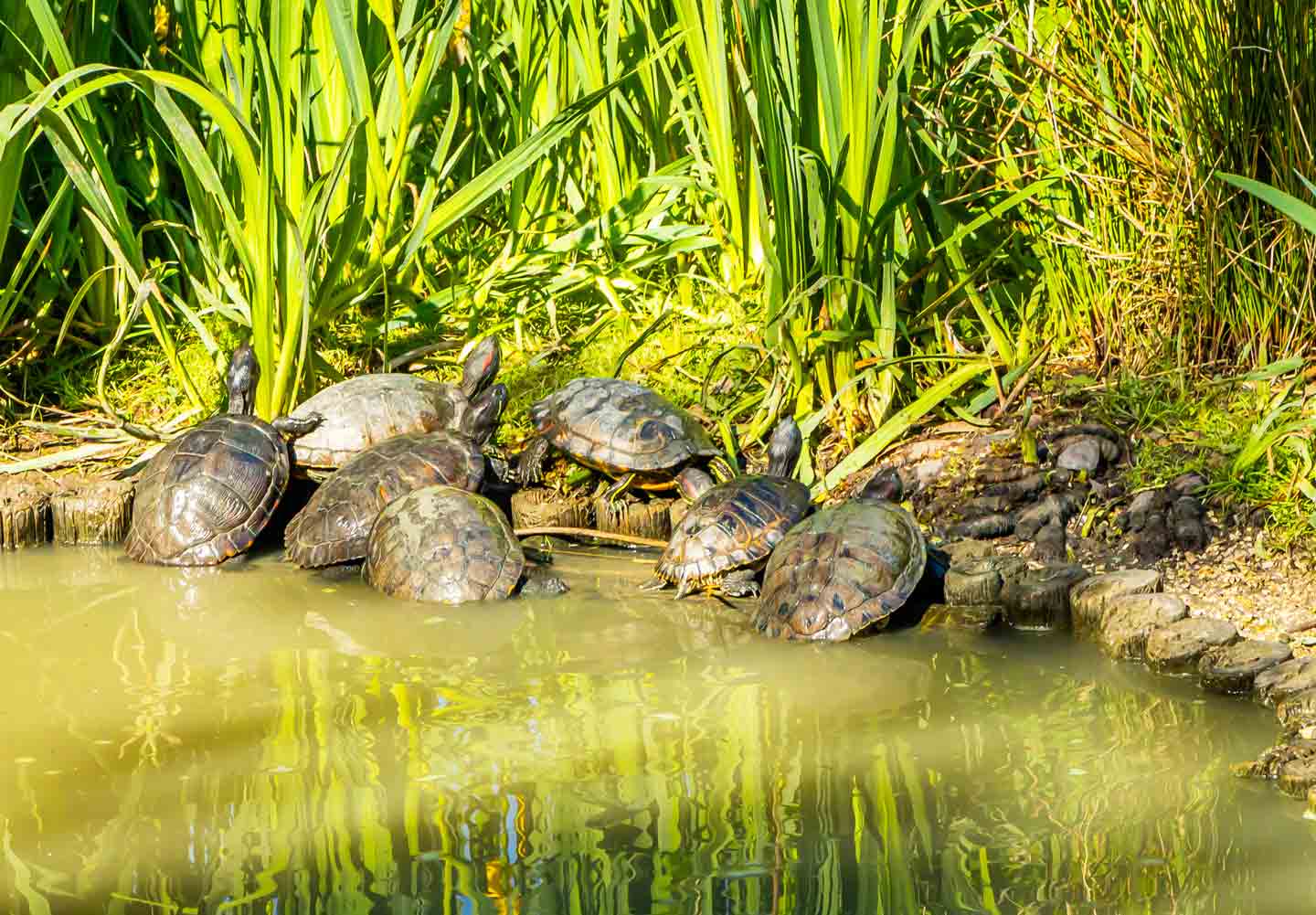
Necessary Pond Equipment
- Marking paint
- Pond filter
- Shovels
- Landscaping underlayment
- Pond liner
- Assorted stones
- Pond lighting
- Aeration equipment (if desired)
- Planting baskets
- Smooth gravel (no larger than 1 inch in diameter)
- Aquatic plant food tabs
- Aquatic plants
- Pond water conditioner
- Bacteria additive
Step-By-Step Guide
- Mark the outline of the pond on the ground using marking paint. If you’re using a preformed pond liner, place it upside down in the desired location, and mark around the outside edge.
- Read the manufacturer’s instructions on your pond filter to decide where to place it—then lay out and connect any necessary tubing.
- Excavate the pond area to the desired depth, taking care to slope the edges. If you’re adding semi-aquatic plants, consider leaving a shallow border inside the edge of the pond so you can plant the roots.
- Level the excavated area and roll out the underlayment. Gently press it into the bottom and sides of the pond.
- Repeat the process with your pond liner. If you’re using a preformed pond liner, make sure it fits snugly into the space with no gaps between the ground and the liner.
- Anchor the underlayment and pond liner by placing large stones at intervals around the edge of the pond.
- Finish installing your pond filter and any other pond equipment according to the manufacturer’s instructions.
- If you’re adding rooted plants, consider planting them in planting baskets or tubs. Place the tubs in the desired locations and fill with a few inches of gravel. Add aquatic plant food tablets to fertilize the roots.
- Fill the bottom of the pond with at least 2 inches of smooth gravel.
- Trim the underlayment and pond liner, leaving 6–8 inches of excess around the border. Fill the gaps with smaller stones or gravel to anchor the edge in place.
- Use a garden hose to fill the pond with fresh water, adding your aquatic plants when the water level gets high enough in the desired location.
- Treat the pond with the appropriate dose of water conditioner based on your pond’s water volume. Consider adding a beneficial bacteria starter as well.
- Turn on your pond equipment and check to make sure everything is working properly.
- Let your pond rest for several weeks to give the liner time to settle and the environment time to complete the nitrogen cycle.
- Test your pond water every few days to monitor the progression of the nitrogen cycle. Once it’s complete, you can start introducing your turtles.
Maintaining Your Turtle Pond
Once your new pond is complete and you’ve introduced your turtles, you’ll need to perform certain tasks to maintain the pond and provide a healthy diet for your turtles.
1. Feeding and Nutrition Tips
Commercial turtle pellets are recommended to meet your turtle’s core nutritional requirements. These pellets can be complemented with fresh vegetables or other plant matter, as well as insects or animal protein. Generally, Dr. Manucy says, “aquatic turtles will require more protein when they are young and more vegetable matter when they are older.”
The nutritional balance of a diet for pond turtles varies depending on the species. For omnivorous species, Dr. Manucy recommends a ratio of “more than 50% plant material, around 25% pellets, and around 25% live animal protein.” A diet for carnivorous turtles should be closer to 50% carnivorous turtle pellets, with 10–20% plant material and 30–40% animal or insect protein.
2. Seasonal Maintenance and Care
Maintenance on a pond for turtles outside is generally done on a monthly or seasonal basis. Follow the manufacturer’s instructions to clean and maintain your filtration system.
You may also need to occasionally trim pond plants, remove surface debris, and service other equipment, like lighting and aeration.
Use a pond water test kit to check the water quality and perform water changes or top-ups as needed. When adding tap water to your pond, be sure to treat it with water conditioner to remove chlorine and heavy metals.
If algae becomes an issue, treat the pond with an algae eliminator or consider investing in a UV clarifier. Tim Wood, an aquascape contractor and owner of Aquatic Edge Pond & Landscape Solutions in Pittsburgh, cautions against overtreating your pond with chemicals, however.
“Every pond will get some algae,” Wood says, “so find an acceptable balance, and learn to appreciate some plants and green algae in the water.”
3. Health and Safety Precautions
Pond turtles are prone to certain health issues like cystic calculi (bladder stones), metabolic bone disease, and shell injuries. A properly balanced diet and exposure to UV light go a long way in preventing disease in turtles.
Make sure any fruit, vegetables, or insects you offer your turtles are free from herbicides, pesticides, and other toxins. Because reptiles like turtles can carry salmonella, always wash your hands after handling your turtles or working in their habitat.
FAQs About Turtle Ponds
Q:Can turtles live in a pond during winter?
A:It depends, says Dr. Manucy: “The species of turtle must be able to withstand colder climates, and there must be at least a foot of unfrozen water underneath the ice layer.” To survive, the turtle will brumate (a form of hibernation exhibited by cold-blooded animals) to slow their metabolism.
Q:Is it safe to swim in a pond with turtles?
A:It depends on the turtle species. Aggressive species like snapping turtles may be tempted to bite. When swimming in a pond with turtles, move slowly to avoid splashing, and give the turtle some space.
Q:Can I put my turtle in a pond?
A:If you already have a semi-aquatic or aquatic pet turtle, you may be able to transition them into an outdoor pond as long as the climate is appropriate. Make the transition at least two months before winter so your turtle has time to acclimate.
Share:
